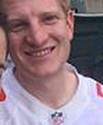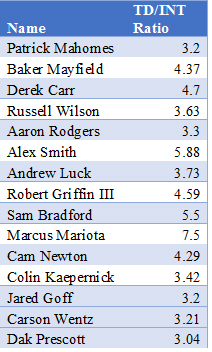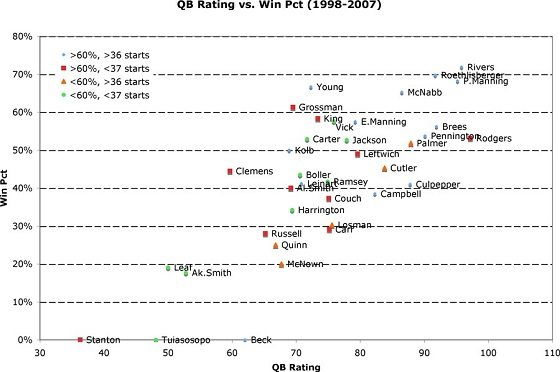AugustUpdate Camp News |
Staff Rankings
| Config Cheat Sheet
| STOMP
Draft Strategies | Depth Charts | Mock Drafts | SOS | Tools | ADP
Diehards Staff Experts Poll | Draft Simulator | University Videos
Draft Strategies | Depth Charts | Mock Drafts | SOS | Tools | ADP
Diehards Staff Experts Poll | Draft Simulator | University Videos
What the numbers tell us about quarterback success and failure in 2019
By Adam Hall
 What the numbers tell us about quarterback success and failure in 2019.
What the numbers tell us about quarterback success and failure in 2019.
Adam Hall
Numbers tell us much of what we need to know
Quarterbacks entering the NFL have played the game at a higher level than most in college, but there are significant differences between resumes of quarterbacks destined for greatness and those who are likely to bust. Over the last three years I have developed a model that with a high degree of certainty can identify future draft busts and point, more frequently than not, to the signal callers that will make up the roster of the Pro-Bowl. Consistent trends point to success and failure, this article will focus on elucidating those factors for the quarterbacks entering the NFL in 2019.
The Model
Bill Parcel had a number of minimum characteristics that he wanted any of his quarterbacks to have achieved. These standards ranged from number of games started/won to height and other innate aspects. I took this idea and ran with it, scouring the internet for work that spoke to this precedent, and analyzed numerous variables on my own. The result is a model with a failure-prediction rate of 100% and a success-prediction rate far above 66%. The Fantasy Sports Writers Association acknowledged the importance of the model by awarding me "Best Fantasy Research Article of 2018" for last year's work, where I stated that Baker Mayfield was the best quarterback to come out of college since Luck and Wilson in 2012.
The standards found to be impactful on future performance are as follows:

Other characteristics including but not limited to: Drop Rate, Percentage of Team Output Based on QB Performance, and Depth of Target are still under investigation since many of the numbers haven't begun to be tracked publicly until recently.
The point of the model is clear: sift through the junk to find how impactful the quarterback has been on his team. From previous study I have found that yards and TDs alone do not point to success; rather, it is the efficiency by which the QB plays the game that carries on to the NFL.
How the Model is Used
The model is split into three major explanatory sections: Trend Characteristics, Success Standards, and Death Knell Stats. Each aspect of the model can belong to multiple sections. By combining the entire picture that is created through the model, we can gauge a quarterback's likeliness for success or failure in the NFL.
Trend Characteristics.
Every variable in the model functions as a positive correlation. In general, the higher the scores on the variables, the more likely a quarterback is to succeed, the lower the scores, the more likely they are to fail. However, there seems to be a steep drop off for quarterbacks who are taller than 78".
In particular, starting more games as a quarterback is highly associated with success on the next level as long as all of the other characteristics are in line with the successful narrative. This is owing to the fact that the events to survey increase and the variables become more stable.
One can see clearly the difference in performance between the three players.

Success Standards
TD/INT Ratio above 3.0
One bright line for success is a TD/INT ratio of 3:1. This benchmark shows that a QB is able to be decisive and deadly with the ball and he avoids mistakes while capitalizing on the opportunities presented. There are few characteristics more important for a QB in the NFL. As time goes on there has been a continuous trend upwards for this number, thus in future years it's likely that this target will change, but for now it's still a great sign of things to come for transitioning quarterbacks.

Other players with at least a 3:1 TD to INT ratio:
Kyler Murray, Dwayne Haskins, Will Grier, Brett Rypien, Easton Stick, Mitch Trubiski, Mason Rudolph, Teddy Bridgewater, Bryce Petty, Tim Tebow, Nathan Peterman, Geno Smith, A.J. McCarron, Brett Hundley, Connor Cook
Games Started and Won Combination
Another prime characteristic that forecasts success in the NFL is a combination of a high number of games started and won. If a QB starts more than 32 games and wins more than 70% of them, he frequently succeeds in the NFL. John Paulsen at Scoresreport tracked this trend back in 2010 and the stats have maintained their consistency since then---you can see his correlation below.

It is important to note that a quarterback can fail to achieve these heights and still succeed in the NFL. Tom Brady mustered a putrid 1.8 TD/INT ratio, while Aaron Rodgers and Cam Newton started 22 and 14 games, respectively. These are indicators of success, not strikes against QBs.
Death Knell Stats
Last year completion percentage under 58.5%
Since 2002, there have been zero quarterbacks who have been successful (average QBR of at least 64 or have been conventionally seen as a top-half quarterback) when they completed fewer than 58.5% of their passes in their final year of college. Furthermore, a last year completion percentage under 60% is nearly always associated with failure in the transition from college to the NFL.
Yards per attempt deficiency
In the last decade no quarterback has been successful with a last year yards per attempt under 7.4.
The last quarterback that upset this standard was Matt Ryan when he completed 59.3% of his passes his final year in college and had a Y/A of 6.89. When we look closer both marks were significantly better in his previous years. Needless to say, Ryan is a statistical aberration that hasn't been repeated in recent years.
Completion percentage 16.2% lower than the best in the nation.
Reddit super-poster Jaguargator9 released his annual quarterback analysis earlier this month, where he found that no quarterback in the modern era has been successful when they ended their career with a completion percentage 16.2% under the most accurate quarterback in the nation. This is a great stat because it scales as the game progresses. Furthermore, the closer one gets to that 16.2% the worse their chances of success become. Having a floor for quarterback performance allows us to parse through the noise to find those that are more hype than substance.
All Signs Point to Yes, Future Franchise Quarterbacks
Unfortunately, this year doesn't have the superstar-level talent of previous years, but there are still players that will have long careers and are worth picking up in dynasty and redraft formats immediately.
Kyler Murray

According to the numbers, the first overall pick in this year's draft has the best chance of being an elite quarterback in the years to come. Murray checks most of the boxes that are indicative of a Pro-Bowl quarterback. Murray's adjusted hand size ranks at first in the class with a spectacular 13.57, while his yards per attempt and TD/INT ratio both place him in the elite category. Nearly every characteristic that is tested in my model loves Murray. There are a couple causes for concern, the fact that he is only 5'10" and may not play at his combine weight leads one to think injuries could hamper his potential. Furthermore, although the Wonderlic may not be the best test to point to a future successful signal caller (the highest scoring quarterback currently playing is Ryan Fitzpatrick), it has consistently pointed to failure when other characteristics failed to. Players like Paxton Lynch looked great across the board, but his poor Wonderlic score foreshadowed his difficulty in adapting to the complex reads and rapid progressions ubiquitous in the NFL. Thankfully Murray has found himself in an offense tailor-made for him to thrive. Murray has even drawn praise from Larry Fitzgerald as quoted by Mike Jurecki on the Cardinal's official website, "He knows the system better than we do," "He can get us into any play at any time, and then he has the ultimate weapon in the exit button." The Cardinals will struggle with growing pains, but with Fitzgerald, Kirk, and David Johnson there to ensure that Murray won't have to throw the team on his back, there's no reason to believe Kyler Murray won't be the offensive rookie of the year.
Dwayne Haskins

Dwayne Haskins has everything that a team would want from their quarterback on paper. He ranks top of the class in completion percentage overall and dwarfs all of the competition in TD/INT ratio (6:1 with the second best being 3.69:1). Numerous scouting reports attest to Haskins' ability to throw with anticipation which is a must in the NFL. It's clear that Haskins is careful with the ball and can place it where he wants to when he wants to. Haskins also boasts a prototypical build at the quarterback position, weighing in at 231 lbs and 6'3". Many writers have compared Haskins to a less error prone Jameis Winston. Unfortunately, Haskins is not the perfect prospect as he only threw for 52 MPH at the Combine, and only a few quarterbacks over the last 18 years have been successful with a mark that low. Deshaun Watson was the most recent success story with a bad arm showing at the Combine, but further analysis found that he throws closer to a 54 MPH fastball than the 50 MPH he threw in Indianapolis. If the radar guns were off as they were with Watson, then Haskins has very little to worry about on the next level. Though if they were on target it's possible that the narrative that Haskins was a creation of the system and his play makers may ring true. Caveats aside, the model loves Haskins as an overall prospect and has some of the best chances of striking gold at the next level.
Future Busts Waiting to Happen
Daniel Jones

With the sixth pick in the 2019 NFL draft, the New York Giants selected Daniel Jones out of Duke. At the time, the pick was pilloried as a ridiculous reach and Dave Gettleman has been a proverbial leper in New York City since. This is for good reason, as my model shows that Jones has the highest bust potential for any player ever drafted this highly. Jones falls beneath the floor of numerous death knell statistics. His yards per attempt register at an unimpressive 6.4 for his career (far beneath the floor of 7.4). His TD/INT ratio only came in at 1.79, he lost more than 50% of his games, and failed to complete 60% of his passes as a starter. Furthermore, his receivers only dropped 9.2% of his passes, which would have been good for 5th best in the SEC last year. If Jones had to grapple with a drop rate closer to Nick Fitzgerald's perhaps one could explain away this lack of consistency, instead Jones was given average receiving efficiency and still couldn't muster NFL caliber production. No quarterback drafted in the last decade has been successful with a TD/INT ratio under 2:1. Jones' resume points to someone who is inaccurate and careless with the football. It seems that the Giants may have been bewitched by his immense frame and his fantastic Wonderlic score (Blaine Gabbert scored a 42 for your information).
There are very few ways to make excuses for Daniel Jones. He started a significant number of games, but didn't progress anywhere near as much as one would want to see. Successful quarterbacks like Matt Ryan and Matthew Stafford started off their careers with rough patches but developed throughout their college careers. Jones failed to show the level of development that even mediocre quarterbacks have demonstrated.

Drew Lock

Although the story isn't as clear cut as with Daniel Jones, things don't look good for Drew Lock. The second-round signal caller failed to amass a career completion percentage higher than 58.5% which has nearly always been a sign of failure in the NFL. Since 2001, only Matthew Stafford has led a successful career while throwing for a sub 58.5% career completion percentage. Lock's other characteristics do not leap off the page like Stafford's. Although Lock was seen as a QB with a big arm and a killer instinct, he only was able to throw a 53.5 MPH fast ball at the Combine, which is eminently uninspiring. Furthermore, his yards per attempt average was rather average, coming in only .5 yards above the death knell level. Finally, his hands are very small for a quarterback of his size, measuring in at only 9". This is a very dangerous sign for quarterbacks who often play in the presence of ice and snow as the ball is harder to grip and manipulate in inclement conditions. Only players who have played in domes or naturally sunny climates have gone on to be successful with 9" or smaller hands (Jared Goff, Tony Romo, Michael Vick).
Lock's success would not be unheard of, but it would be a significant statistical anomaly, play the numbers and stay away from him in dynasty and redraft leagues.
Flying Under the Radar, Under-Drafted Quarterbacks with Big Potential.
Not every quarterback worth his salt is drafted in the first two rounds. The model frequently identifies players like Nick Foles, Dak Prescott, Kirk Cousins, and Russell Wilson who fell through the cracks of the scouting process. Not every player that fits the bill will go on to win Superbowls, but out of the lot of quarterbacks this year these two have the best chance of beating the odds.
Will Grier

Across the board there is nothing to complain about with Will Grier as a prospect according to the model. Grier has the best ball speed in the class with a 58.5 MPH fast ball, while earning an elite score in Last Year completion percentage, TD/INT ratio, and Last Year Y/A. Grier doesn't have any of the yellow or red flags associated with other top prospects. His hands are more than big enough to be successful and a 6'2" 220 lbs frame is large enough to stay healthy in the NFL, all while scoring a 30 on the Wonderlic which firmly answers any questions about his ability to engage with an NFL playbook. Furthermore, Grier ranked top in the country in Big Time Throws with 32 according to Pro Football Focus (PFF). These are the hardest throws to make, often coming at a long down and distance or at pivotal points in the game. Grier's clutch play was epitomized against Texas as Grier kept The Mountaineers in Big-12 contention with his game ending touchdown when no other alternative would have done it. This is not something that is quantified in the model, but is often a characteristic of players that succeed in the NFL. Finally, Grier handles pressure exceptionally well as long as his protection holds up, according to PFF, Grier completed 68.5 % of passes against the blitz with a 22-to-0 touchdown-to-interception ratio. When taken as a complete picture, Will Grier has the potential to be more than a competent starter, but one that could lead a franchise deep in the playoffs.
Brett Rypien

Over 48 games Rypien completed 64% of his passes which is exceptional for a career that spanned four seasons. Not only was he able to put the ball where he wanted, he was undeterred from taking risks, maintaining a hardy 8.4 career yards per attempt which is good for 5th best in the class. There are no glaring weaknesses in Rypien's resume, which is critical to beat the odds. One characteristic crucial for an underrated player to succeed is arm strength which Rypien has in droves. His 57.5 MPH fastball was second in the class, outpacing the likes of Dwayne Haskins and Kyler Murray across the board. If Rypien is able to make waves in the pre-season, he could find himself on the Broncos' roster. Given his displayed potential, Rypien could create an opportunity for himself in the coming weeks, crazier things have happened than an undrafted free agent putting himself in a position to start when the situation presents itself.
